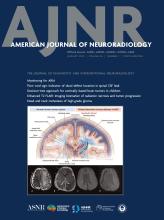This article requires a subscription to view the full text. If you have a subscription you may use the login form below to view the article. Access to this article can also be purchased.
Abstract
BACKGROUND AND PURPOSE: Contrast-enhanced MRI (CEMRI) is a commonly used imaging technique for craniopharyngioma surveillance; however, it carries risks such as allergic reaction and gadolinium deposition. This study evaluates the efficacy of non contrast–enhanced MRI (NCMRI) with a balanced steady-state free precession (bSSFP) sequence compared with CEMRI T1-weighted imaging for craniopharyngioma surveillance.
MATERIALS AND METHODS: Twenty-nine patients with craniopharyngioma (16 females/13 males, mean age =21.5 ± 4.3 years) with CEMRIs, including a bSSFP sequence, were evaluated. For each patient, 2 blinded neuroradiologists compared the dimensions of residual craniopharyngioma on non-contrast– and contrast-enhanced sequences. Tumor volume and solid/cystic component measurements were evaluated by using paired t-tests. Diagnostic confidence levels for non-contrast– and contrast-enhanced evaluations were measured by using a 3-point scale (2 = confident, 1 = adequate, 0 = unsure). Analyses of tumor involvement of cranial nerves (CNs) and adjacent vasculature and diagnostic confidence were performed by using Fisher exact and chi-square tests.
RESULTS: No significant difference was observed between residual tumor volumes in both studies (18.86 ± 21.67 cm3 versus 17.64 ± 23.85 cm3, P = .55) and measurements of dominant solid component volume, number of cystic components, and largest cystic component volume (2.71 ± 3.47 cm3 versus 3.95 ± 5.51 cm3, P = .10; 2.5 ± 1.5 versus 2.9 ± 1.5, P = .10; 7.61 ± 13.41 versus 6.84 ± 13.37 cm3, P = .22, respectively). Tumor involvement of CNs II (P = .64), III (P = .42), and adjacent vasculature (P = .05) showed no significant differences in detection. Diagnostic confidence was comparable in evaluating CN II, vascular structures, and third ventricle (P > .05) involvement. Higher levels of confidence were observed with bSSFP sequences for the detection of CN III involvement (P = .0001) and with contrast-enhanced T1-weighted imaging for cavernous sinus involvement (P = .02).
CONCLUSIONS: NCMRI techniques by using a bSSFP sequence provide similar characterization of craniopharyngiomas as contrast-enhanced techniques.
ABBREVIATIONS:
- ACA
- anterior cerebral artery
- bSSFP
- balanced steady-state free precession
- CEMRI
- contrast-enhanced MRI
- ce-T1W
- contrast-enhanced T1-weighted imaging
- CN
- cranial nerve
- NCMRI
- non-contrast–enhanced MRI
- TR
- total resection
- © 2025 by American Journal of Neuroradiology












